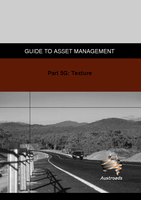Asset Management

- Publication no: AGAM05G-09
- ISBN: 978-1-921551-67-3
- Published: 22 July 2009
- Edition: 1
- Superseded
- PDF (free) Download
Guide to Asset Management Part 5G promotes the collection of road surface texture data as an important component of site investigative and road network management in Australia and New Zealand. The guide primarily focuses on one measure of texture, namely macrotexture, due to its important contribution to the available level of friction at the interface between vehicle tyre and road surface, and especially at high vehicle speeds and/or in wet conditions. The guidelines describe the different methods routinely used to measure texture in Australia and New Zealand and explain the need to consider the results obtained alongside skid resistance measurements. The texture of a road surface makes a vital contribution to the total available level of friction at the contact patch between vehicle tyre and road surface, and particularly so at higher vehicle speeds and/or in wet conditions.
- 1. INTRODUCTION
- 1.1. Context within Guide to Asset Management and Acknowledgements
- 1.2. Overview of Texture
- 1.3. Objective
- 2. SPECIFICATION AND TEST METHOD
- 2.1. Definition of Texture
- 2.2. Frequency of Texture Testing
- 2.3. Data Reporting
- 3. TOOLS AND TECHNIQUES
- 3.1. Types of Texture Measuring Device
- 3.1.1. Volumetric Method (Sand Patch/Sand Circle)
- 3.1.2. Laser Profile Method
- 3.2. Measurement of Texture
- 3.2.1. Mean Profile Depth (MPD)
- 3.2.2. Sensor-Measured Texture Depth (SMTD)
- 3.2.3. Texture Loss
- 3.2.4. Relationship between MPD, SMTD and Historical Volumetric Methods
- 3.2.5. Speed Dependency
- 3.2.6. Ability to Measure Low Texture Levels
- 4. DATA QUALITY AND VALIDATION
- 4.1. Validation of Distance Measurement
- 4.2. Validation of Texture Measurement
- 4.3. Repeatability and Bias
- 5. ANALYSIS
- 5.1. Assessing the Validity of Surface Texture Data
- 5.2. Distribution Analysis
- 5.3. Policy on the Release of Surface Texture Data to the Public, Media and Legal Profession
- 6. APPLICATION
- 6.1. General
- 6.2. Network Screening
- 6.3. Work Prioritisation
- 6.4. Performance Indicators
- 6.5. Indicative Investigatory Levels
- 6.6. Decision–support Tools
- 6.7. Network Performance Scenario Analysis
- 6.8. Budget Forecasting
- 7. TEXTURE COLLECTION AT INVESTIGATIVE (SITE) LEVEL
- REFERENCES
